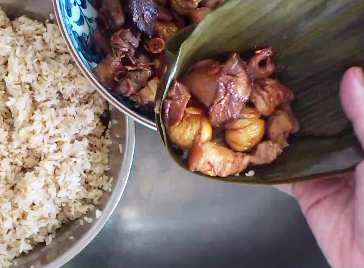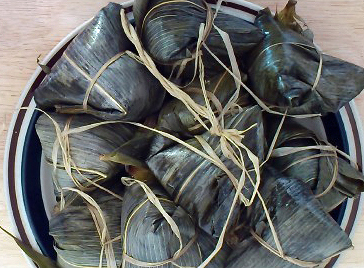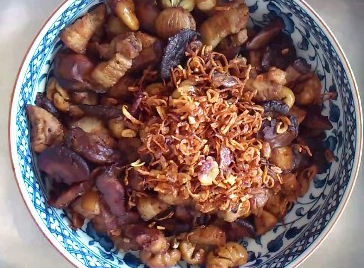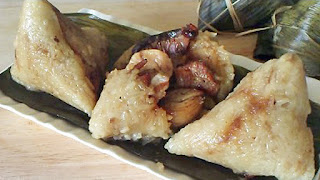Bak Chang (Meat Rice Dumplings)

My mother made two types of 粽子 every year, kee chang and bak chang.
Kee chang is quite straightforward. It’s just glutinous rice mixed with lye water, wrapped in bamboo leaves, then boiled.
Bak chang, however, is extremely varied in ingredients, seasoning, cooking method, and shape, depending on which part of China your family is from.
For us – we’re Teochews – there’re two types indigenous to our culture.
The more elaborate type, called 双烹, has a small ball of sweet red bean paste wrapped in leaf lard.
My mother always did the simpler type without sweet red bean paste. The filling is 100% savory with pork belly, chestnuts, mushrooms, dried prawns and fried shallots.
The actual process of making bak chang was spread over two days.
On the first day, bamboo leaves and dumpling strings were sorted, soaked and washed. Rice was soaked too, as were the mushrooms, dried prawns and dried chestnuts.
On the second day, the filling and rice for bak chang were stir-fried and wrapped, then boiled for 3-4 hours.
Whilst the savory meat dumplings were being cooked – over a wood fire so as to save on gas! – Mum did the kee chang. These were much easier than bak chang since they didn’t have any filling, and the rice wasn’t stir-fried.
Mum was quite proud of her bak chang. Every year, she gave some to a few relatives and they gave her theirs in return.
My mother tasted each and everyone’s dumplings versus her own, and then she’d quietly declare herself the winner of the dumpling making contest.
The contest was weird. The contestants, other than my mother, didn’t even know it existed. There was only one judge, who was the only contestant who knew about the contest.
One year, the day after making dumplings, I found my mother looking like a panda. She had dark circles around her eyes.
She hadn’t slept well the night before, she said.
What happened?
Mum’s bak chang wasn’t as good as in previous years.
Why not?
Because she didn’t stir-fry the glutinous rice.
Mum was getting on in years and wasn’t as sprightly as before. So she simplified things a bit, skipping what she’d thought wasn’t a crucial step. She made bak chang without stir-frying the rice. Hence, the sleepless night.
Mum decided to make a second batch of bak chang, this time with the rice properly stir-fried. Everyone said, “NOOOOO! NO WAY!” But she just ignored us.
That was the only time she did two rounds of bak chang in one year. And that’s why it’s been burnt into my brain: fry the friggin’ rice!

Bak Chang
Video
Ingredients
Wrapping
- 30 large bamboo leaves
- 30 small bamboo leaves
- 30 pieces dumpling strings or plastic raffia each about 90 cm long
Filling
- 50 dried chestnuts, about 200 g
- 70 g dried prawns
- 70 g Chinese dried mushrooms
- 200 g shallots
- 120 ml corn oil
- 550 g pork belly – rinse and cut bite-sized into 50 pieces
- 3 tbsp light soya sauce
- 1 tsp salt
- ¼ tsp sugar
- ½ tsp dark soya sauce
Rice
- 1 kg long-grain glutinous rice
- 3 tbsp light soya sauce
- 1 tsp salt
- ½ tsp ground white pepper
- ¼ tsp sugar
- ½ tsp chicken powder
Instructions
Wrapping
- Day 1 – Check that large and small bamboo leaves aren't torn or have holes. Soak overnight in enough water to cover (weighed down with something heavy). Wipe clean and rinse thoroughly. Set aside.30 large bamboo leaves, 30 small bamboo leaves
- If using dumpling strings, discard thin ones that may break (test by pulling). Thick ones may be split into 2. Soak strings overnight with bamboo leaves. Rinse till water runs clear. Wring dry. Tie to a pole with a slip knot. Rest pole between back of two chairs or maybe kitchen cabinets and a table.30 pieces dumpling strings or plastic raffia
Filling
- Day 1 – Rinse dried chestnuts. Soak overnight in enough water to cover by 5 cm, refrigerated. Remove peel with toothpick. Trim black spots if any. Rinse and drain.50 dried chestnuts, about 200 g
- Rinse dried prawns. Soak overnight in 4 tbsp water, refrigerated. Squeeze dry, reserving soaking liquid.70 g dried prawns
- Rinse dried mushrooms. Soak overnight in 120 ml water, refrigerated. Squeeze dry, reserving soaking liquid. Cut bite-sized into 50 pieces (reserving stems for making stock some other day.)70 g Chinese dried mushrooms
- Peel and rinse shallots. Slice thinly. Refrigerate till ready to use on day 2.200 g shallots
- Day 2 – Fry shallots in corn oil over medium till lightly golden. Turn off heat. Continue stirring till residual heat dissipates. Remove shallots to a colander. Remove half of the oil to a bowl. This is for frying rice.120 ml corn oil
- Turn on heat to maximum possible. Fry dried prawns till lightly golden. Add mushrooms and stir till heated through. Add chestnuts and stir till heated through. Add pork and stir-fry till slightly brown. Season with light soya sauce, salt and sugar. Stir till absorbed. Drizzle with water drained from dried prawns. Stir till dry. Drizzle with half of water drained dried mushrooms. Stir till dry. Drizzle with remaining mushroom water. Stir till dry. Add dark soya sauce and ground white pepper. Stir through.550 g pork belly – rinse and cut bite-sized into 50 pieces, 3 tbsp light soya sauce, 1 tsp salt, ¼ tsp sugar, ½ tsp dark soya sauce
- Taste and adjust seasoning if necessary. (Taste should be slightly saltier than usual.) Transfer to a bowl. Drizzle 2 tbsp water around wok. Stir to deglaze. Turn off heat. Add water to pork mixture. Stir till absorbed. Add half of fried shallots (remaining half to add to rice). Stir till evenly mixed.
- Wash and dry wok. Proceed to fry rice as detailed below.
Rice
- Day 1 – Rinse glutinous rice till water runs clear. Soak overnight in enough water to cover by 5 cm. Drain thoroughly.1 kg long-grain glutinous rice
- Day 2 – Place remaining shallot oil in the wok and heat till just smoking. Add glutinous rice, then remaining fried shallots. Stir till thoroughly heated. Season with light soya sauce, salt, sugar, chicken powder and ground white pepper. Stir till well mixed.3 tbsp light soya sauce, 1 tsp salt, ½ tsp ground white pepper, ¼ tsp sugar, ½ tsp chicken powder
- Taste (but do not eat because rice is still raw) and adjust seasoning if necessary. (Rice should be a bit saltier than usual because seasoning will be diluted by boiling water.) Transfer to a bowl.
Assemble + cook
- Day 2 – Rest pole horizontally on back of two chairs, or maybe kitchen cabinets and a table. Pole should be secure and not roll about when dumplings are being tied. You also need a low stool to sit on.
- Tie dumpling/raffia strings to pole with slip knot.
- Wrap and tie dumplings as shown in video (4:04 – 5:02).
- Boil dumplings for 3 hours, totally submerged in water. Unwrap one and see if rice is soft. If it isn't, boil another 15-30 minutes.
- Remove cooked dumplings from water. May be eaten immediately if you like. Or leave to drain and cool down, then serve warm or at room temperature. Refrigerate leftovers. Steam or microwave to reheat thoroughly before eating.